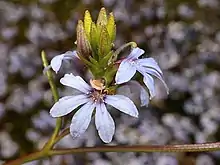| Silky scaevola | |
|---|---|
 | |
| Scaevola thesioides in Kings Park | |
| Scientific classification | |
| Kingdom: | Plantae |
| Clade: | Tracheophytes |
| Clade: | Angiosperms |
| Clade: | Eudicots |
| Clade: | Asterids |
| Order: | Asterales |
| Family: | Goodeniaceae |
| Genus: | Scaevola |
| Species: | S. thesioides |
| Binomial name | |
| Scaevola thesioides | |
| Synonyms[1] | |

Scaevola thesioides is a species of flowering plant in the family Goodeniaceae and is endemic to the southwest of Western Australia. It is a spreading subshrub to perennial herb with thread-like to lance-shaped leaves and hairy, fan-shaped, pale blue to white flowers.
Description
Scaevola thesioides is a spreading subshrub to perennial herb that typically grows to a height of up to 1 m (3 ft 3 in) and is mostly glabrous. The leaves are sessile, thread-like to lance-shaped with the narrower end toward the base, 15–70 mm (0.59–2.76 in) long and up to 1–5 mm (0.039–0.197 in) wide. The flowers are arranged on the ends of branches in spikes up to 40 mm (1.6 in) long. The bracts are narrowly triangular or thread-like, 4–14 mm (0.16–0.55 in) long and the bracteoles thread-like and 2–6 mm (0.079–0.236 in) long. The petals are 5–9 mm (0.20–0.35 in) long, light blue to white, hairy inside, the wings about 0.6 mm (0.024 in) wide. Flowering mainly occurs from August to December and the fruit is cylindrical to oval, and about 3 mm (0.12 in) in diameter.[2][3]
Taxonomy
Scaevola thesioides was first formally described in 1837 by George Bentham and the description was published in Enumeratio plantarum quas in Novae Hollandiae ora austro-occidentali ad fluvium Cygnorum et in Sinu Regis Georgii collegit Carolus liber baro de Hügel.[4] The specific epithet (thesioides) means Thesium-like.[5]
Distribution and habitat
This scaevola grows in near-coastal areas of south-western Western Australia in the Coolgardie, Esperance Plains, Geraldton Sandplains, Mallee and Swan Coastal Plain bioregions.[2][3]
References
- 1 2 "Scaevola thesioides". Australian Plant Census. Retrieved 13 October 2022.
- 1 2 Carolin, R.C. "Scaevola thesioides". Flora of Australia. Australian Biological Resources Study, Department of Agriculture, Water and the Environment. Retrieved 13 October 2022.
- 1 2 Paczkowska, Grazyna. "Scaevola thesioides". FloraBase-the Western Australia Flora. Department of Biodiversity, Conservation and Attractions. Retrieved 13 October 2022.
- ↑ "Scaevola thesioides". Australian Plant Name Index. Retrieved 13 October 2022.
- ↑ Sharr, Francis Aubi; George, Alex (2019). Western Australian Plant Names and Their Meanings (3rd ed.). Kardinya, WA: Four Gables Press. p. 323. ISBN 9780958034180.